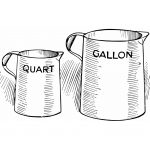
By Al Adcock, VP of Sales and Marketing at B&C Technologies

Why are commercial washers and commercial dryers sold by capacity in pounds? After all, when you purchase just about any other cylinder shaped object (like a washer basket or dryer basket) it would be rated in some unit of volume (quarts, gallons, bushels, etc.). Most laundry carts have their capacities listed in bushels. Even a lowly bucket has its capacity shown in quarts or gallons. So why is there a difference when it comes to your washer or dryer?
I think the reason for this is that it is much easier to print a new decal and a new brochure that has a larger number on it than it is to design a newer and larger machine that actually holds more laundry. Plus, it is fairly difficult to verify how much laundry a given machine can hold if we are measuring in pounds. You could certainly load a machine with bricks and squeeze in 65 pounds. You will have a much tougher time getting 65 pounds of terry towels in some commercial washer–extractors on the market today (even if they claim to hold 65 pounds)!
Unfortunately, the logical conclusion to all of this size inflation is a complete misunderstanding about the actual capacities of a given washer or dryer. That is why understanding cylinder volume is so important.
What is Volume, Anyway?
 Simply put, Volume is how much stuff a given container can hold (at least in our context). That stuff could be water, air, or dirty laundry. In a given washer, we’ll have all three, plus some helpful laundry chemicals to get it all clean.
Simply put, Volume is how much stuff a given container can hold (at least in our context). That stuff could be water, air, or dirty laundry. In a given washer, we’ll have all three, plus some helpful laundry chemicals to get it all clean.
When you’re trying to get the laundry done in a reasonable amount of time, you definitely want the right amount of big. Too big and you’ll run the risk of running the machine underloaded which is a bad thing for front load washers of any kind.
Why is Volume Important?
 Let’s say you are comparing 2 different brands of washers, both claiming to be 65 pounds capacity. One has a wash cylinder with 9.7 cubic feet of volume. The other has 8.8 cubic feet of volume. Which one will hold more towels? If you answered 9.7 cubic feet, go to the head of the class!
Let’s say you are comparing 2 different brands of washers, both claiming to be 65 pounds capacity. One has a wash cylinder with 9.7 cubic feet of volume. The other has 8.8 cubic feet of volume. Which one will hold more towels? If you answered 9.7 cubic feet, go to the head of the class!
Use Your New Knowledge!
 Now that you have learned all about volume and why it is important, you can save money! One of the easiest things to look at when purchasing a new commercial washer or commercial dryer is your cost per cubic feet of volume. This very simple calculation completely levels the playing field and makes it plain how much a washer truly costs. It is a very simple bit of math:
Now that you have learned all about volume and why it is important, you can save money! One of the easiest things to look at when purchasing a new commercial washer or commercial dryer is your cost per cubic feet of volume. This very simple calculation completely levels the playing field and makes it plain how much a washer truly costs. It is a very simple bit of math:
Cost per cubic foot = Washer cost / cubic feet capacity
We can go back to our example above and plug in some numbers:
Brand A, 9.7 cubic feet, costs $7,600.
Brand B, 8.8 cubic feet, costs $7,200.
Which one is the better value?
Brand A: $783.50 per cubic foot
Brand B: $818.18 per cubic foot
Sometimes size truly does matter!
About the Author:
 Al Adcock is VP of Sales and Marketing at B&C Technologies. He is an industry veteran with over 29 years of experience, working for different manufacturers in many different capacities before helping launch B&C Technologies in 2000. Adcock has played an instrumental role in the design of several machines on the market before moving to sales in 2013.
Al Adcock is VP of Sales and Marketing at B&C Technologies. He is an industry veteran with over 29 years of experience, working for different manufacturers in many different capacities before helping launch B&C Technologies in 2000. Adcock has played an instrumental role in the design of several machines on the market before moving to sales in 2013.
Based in Panama City Beach, FL, B&C Technologies is a family-owned customer-focused company that builds the highest quality laundry equipment at the most competitive prices. All B&C equipment relies on engineering-driven designs to produce machines that consistently perform and constantly produce.













